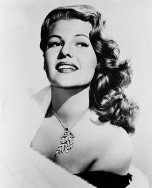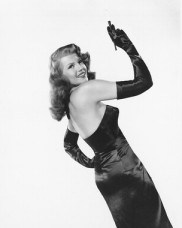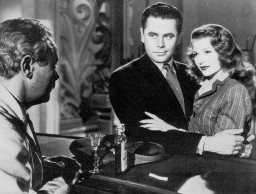 Who is the blogger?
Who is the blogger?
To see a simple English version of reviews about some of the movies, click on the ESL section of Midnight Oil.
It Happened One Night (1934)
 Claudette Colbert and Clark Gable define “Capraesque” in this madcap Depression era comedy that marries glamour and glitz to populist sentiment. Tag along for a wild ride with this TVO Saturday Night at the Movies special on Frank Capra’s classic Hollywood film .
Claudette Colbert and Clark Gable define “Capraesque” in this madcap Depression era comedy that marries glamour and glitz to populist sentiment. Tag along for a wild ride with this TVO Saturday Night at the Movies special on Frank Capra’s classic Hollywood film .
See the video preview from TVO
The Good Old Bad Old Days
I sometimes wonder if my grandmother would have gone to see a film like “It Happened One Night” at the movie theatre. I look at black and white photos with the funny old hats and the rattletrap black Model Ts and chuckle. . .
>> See the complete archived review of "It Happened One Night" on Midnight Oil
Catch the video trailer of "It Happened One Night"
Related Reading:
- Bible quiz time: Did the original story of the walls of Jericho occur in the book of Exodus (apologies to Paul Newman), Deuteronomy, or Joshua (not the guy with the bad hair in Cecil B. De Mille production)
- The junk in the trunk: How the stuff you forgot to unpack after the honeymoon was over can skuttle even the best of relationships
- “Yes, but will she still respect you in the morning?” Respect in communication as a missing ingredient.
- Director/producer Frank Capra was the originator of the “one man, one film” concept. Whose name gets top billing on your life’s story?
Elmer Gantry (1960)
 Burt Lancaster does some very interesting work in both "Elmer Gantry" (1960) INDb and "The Swimmer" (1968) INDb. Both films prove to be revelatory in both the figurative and the literal sense:) These screen adaptations of literary vehicles might leave you slightly off balance, but still glued to the screen.
Burt Lancaster does some very interesting work in both "Elmer Gantry" (1960) INDb and "The Swimmer" (1968) INDb. Both films prove to be revelatory in both the figurative and the literal sense:) These screen adaptations of literary vehicles might leave you slightly off balance, but still glued to the screen.
This movie was paired with a second feature, "The Swimmer" when originally aired on TVO. See the entire archived entry.
Catch the video trailer for "Elmer Gantry"
Jane Austen series on TVO
See the cool Austen mini docs for TVO's Sunday Specials: the Jane Austen series

TVO recently screened "Northanger Abbey"(2007) , "Mansfield Park" (2007), and "Persuasion"(2007) in a festival of seldom seen Austen novels on film. Those permanently afflicted with the Austen bug may wish to find solace and companionship online at the Jane Austen Society of North America. You may also wish to read the Midnight Oil archived entry for the Emma Thompson 1995 version of Sense and Sensibility" previously screened on SNAM. Catch the video trailer.
Christmas in Connecticut (1945)
A Hunky Dunky Holiday
 This Christmas on TVO's SNAM, Barbara Stanwyck and Dennis Morgan whip up some silly and frothy holiday fare that's just right for those of us who are in the mood for some seasonal schmaltz.
This Christmas on TVO's SNAM, Barbara Stanwyck and Dennis Morgan whip up some silly and frothy holiday fare that's just right for those of us who are in the mood for some seasonal schmaltz.
Catch the TVO video preview.
Christmas day. It’s a day full of time-honoured traditions, culinary and otherwise: turkey and trimmings, my mother’s infamous orange jello salad and the traditional figgy pudding with brown sugar sauce.
I spent the day fluffifying, de-fluffifying and re-fluffifying my six year old daughter’s Li’l Lovables Tickle Teddy. (It’s a make-your-own personalized teddy bear craft kit complete with a fluff spinner and teddy adoption papers.)
My son industriously set about constructing his LEGO Star Wars Jedi Starfighter with hyperdrive booster ring.
My brother spent nearly the entire Christmas noontime meal cynically lamenting about the R.O.I.(return on investment) of his World Vision micro-industry chicken and rooster gift set. (My brother says he wants the charitable organization to provide an annual report of how many eggs the chickens have laid and how much profit his investment has generated for the recipient family.)
Hammy the hamster spent her time snoozing soundly after snacking away on her Christmas hamster treats and getting a good workout on her hamster wheel on Christmas Eve. Hammy’s cage was installed right near the Christmas tree. Even though Hammy was awake for most of the night in this excellent vantage point, she was unable to provide us with any reports of a sighting of Santa. Anything that happens during her nocturnal activities while the rest of the family is asleep tucked up in their beds she generally keeps pretty much to herself.
It’s really easy at Christmas time to enter into some kind of a weird headspace that’s chock-full of ooey gooey sentimentality and high calorie nostalgia. We should all know better by now than to indulge, but for some reason, because it’s the holiday season, we just let ourselves go and run hog wild with the schmaltz and the schlock.
 For me, a movie like "Christmas in Connecticut" fits in there somewhere in that weird headspace. In his annual Christmas letter, a distant relative of mine recommended "It’s a Wonderful Life", "The Bishop’s Wife" and "White Christmas" for holiday season viewing pleasure.
For me, a movie like "Christmas in Connecticut" fits in there somewhere in that weird headspace. In his annual Christmas letter, a distant relative of mine recommended "It’s a Wonderful Life", "The Bishop’s Wife" and "White Christmas" for holiday season viewing pleasure.
They are all good films for cuddling up on a cozy winter’s evening while slurping up the egg nog and gobbling left-over turkey and cranberry sauce sandwiches. (Honestly, who eats turkey and cranberry sauce sandwiches at any other time of the year? I guess it’s kind of a hazard of our holiday habits that include dining on oversized birds.)
"Christmas in Connecticut" appears to be firmly ensconced in the North American film répertoire as one of those ‘B’ type movies that the TV networks feel they can safely pull out during the holidays and still do something to maintain their ratings. (Maybe it’s due to that "weird headspace" phenomenon that goes on.)
Now, if I were one to quibble, I might argue that there are moments during "Christmas in Connecticut" that cause the Catherine "film-o-metre" to dip down dangerously low into the ‘C’ type film range. But, as most of us are feeling especially full of peace and goodwill towards all mankind these days, we won’t focus on that type of negativity.
 I can sort of relate to the Elizabeth Lane character as played so ably by Barbara Stanwyck. Ms. Lane, a smart and sophisticated career woman, suddenly finds herself embroiled in a hair brain scheme that includes pretending that she has the ideal life circa 1945 which includes a husband, a hobby farm and a baby. In order to avoid a capital CLM (career limiting move), Ms. Lane embarks upon her merry pathway of deceit and diversion with the help of a number of co-conspirators.
I can sort of relate to the Elizabeth Lane character as played so ably by Barbara Stanwyck. Ms. Lane, a smart and sophisticated career woman, suddenly finds herself embroiled in a hair brain scheme that includes pretending that she has the ideal life circa 1945 which includes a husband, a hobby farm and a baby. In order to avoid a capital CLM (career limiting move), Ms. Lane embarks upon her merry pathway of deceit and diversion with the help of a number of co-conspirators.
Although we might look back on this film and be slightly bemused by another generation’s conception of what constitutes either the ideal woman or the ideal upper middle class lifestyle, I think that the film still holds some ground in that it depicts a basic conflict that many women of this generation still encounter. Lots of women today still struggle with pursuing career and balancing it off with quality family life. Some of the factors in the equation and the conclusions to the dilemma may have changed over the years, but the essential struggle still continues for many.
A cast of minor characters help Barbara Stanwyck maintain the façade of the idyllic country life of the perfect homemaker slash famous columnist. Particularly memorable amongst them are the cook, Uncle Felix (S.Z. Sakall) and Norah the housekeeper (Una O’Connor). Uncle Felix together with Norah supply things that are evidently missing with the Elizabeth Lane character: Uncle Felix provides wonderful culinary arts and a robust sentimentality while Norah fills in with her common sense home making skills and heightened moral sensibilities.
 No one can live up to self-perpetuated illusions of perfection. Elizabeth Lane finds herself in a real pickle because of the creation of the pseudo-identity of the ideal female role model for her column’s readership.
No one can live up to self-perpetuated illusions of perfection. Elizabeth Lane finds herself in a real pickle because of the creation of the pseudo-identity of the ideal female role model for her column’s readership.
Happily, by the end of the film, Ms. Lane discovers that she doesn’t have to be the ideal woman in order to luck out and get a storybook romance ending. Jefferson Jones (Dennis Morgan) as the obligingly eligible bachelor is more than willing to participate in the mayhem of the moment. He manages to keep a smile on his face and adapt quite well through the convoluted mishaps that include a broken engagement, a baby’s gender confusion and a night in jail.
 With the part of Elizabeth Lane, Barbara Stanwyck appears to be well underway with playing the part of the tough as nails female character for which she became famous. The screwball comedy genre in this case helps us to see the other side of that character; the soft, feminine and even naïve side of a woman who wants to just cut loose and fall in love with love.
With the part of Elizabeth Lane, Barbara Stanwyck appears to be well underway with playing the part of the tough as nails female character for which she became famous. The screwball comedy genre in this case helps us to see the other side of that character; the soft, feminine and even naïve side of a woman who wants to just cut loose and fall in love with love.
Anyways. All’s well that ends well. Everything in this film finishes up just "hunky dunky", as Uncle Felix would say, just as it should in 1945 on the cusp of the post-war era. Never mind what lies have been told, what improbabilities have been ignored and what awkward realities have been easily smoothed over. It’s the Christmas season. At times like this we’re as willing to overlook such things as easily as we forgive the fake snow scene on a Hollywood back lot. Everyone, along with Ms. Elizabeth Lane, is poised to enjoy the wholesome, positive atmosphere that engulfs the promising new beginnings of a New Year.
Suggested Reading:
- Living the not-so-perfect Christmas holiday
- Getting beyond Christmas kitsch
- Living with the phantom perfect woman: Getting comfortable with the skin you're in
- Tired of failed New Year's Resolutions? Get over the guilt and move forward
Gilda (1946)
The Games People Play
 “There never was a woman like Gilda!” There never was a film like “Gilda”. TVO’s discussion of the Femme Fatale during the Interviews (Aug.18/07) examines Rita Hayworth and the fascinating subject of the female role in film noir.
“There never was a woman like Gilda!” There never was a film like “Gilda”. TVO’s discussion of the Femme Fatale during the Interviews (Aug.18/07) examines Rita Hayworth and the fascinating subject of the female role in film noir.
Video trailer of "Gilda" (1946)
I hurt my back a week or so ago. Youch! The injury? Bending over and tying my shoelaces. While I was sitting down. On the toilet seat, if you must know, with the toilet lid closed. I had just finished with my exercises for the day and was taking off my running shoes. I spent the rest of the day hobbling around with the aid of a broomstick. I spent the rest of the week wondering whether I had done right to leave my broomstick behind whenever I went out the door.
Now, does this mean that I will never engage in exercise again for fear of injuring my back? Never wear shoes with shoelaces? Never sit on a toilet seat ? Well, I could do that, but it would curtail my lifestyle pretty severely, not to mention being unhealthy. (Never sit on a toilet seat again? Let’s not go there in terms of healthy lifestyle choices. I could get into the debatable medical merits of “squatting”, but . . . )
 Both life’s experiences and considerable stud y have taught me that the human body has immense recuperative powers, provided that we don’t get in the way. . .
Both life’s experiences and considerable stud y have taught me that the human body has immense recuperative powers, provided that we don’t get in the way. . .
“I knew it scared her. Anyone as superstitious as Gilda . . .asking for disaster,” The voice over narrative of Johnny Farrell played by Glenn Ford provides us with clues as to the “proper” interpretation of different dramatic and psychological elements of this film. The character of Gilda definitely has her foibles, superstition being one of them. Gilda’s superstitious streak makes for a nice touch, helping to create the sense of foreboding that is so deliciously played up in this film noir classic.
 Superstitious though she may be, Johnny’s observation about his “ex” manages to avoid the one most obvious thing about Gilda: she’s a knock-out. Rita Hayworth in 1946 in her heyday is quite the sight. Rita’s former career as a dancer, the extra electrolysis work on moving back the hairline, the red hair dye, the post-pregnancy girdle, the song dubbing by Anita Ellis; it all works together to create a marvelous onscreen effect.
Superstitious though she may be, Johnny’s observation about his “ex” manages to avoid the one most obvious thing about Gilda: she’s a knock-out. Rita Hayworth in 1946 in her heyday is quite the sight. Rita’s former career as a dancer, the extra electrolysis work on moving back the hairline, the red hair dye, the post-pregnancy girdle, the song dubbing by Anita Ellis; it all works together to create a marvelous onscreen effect.
Oops! Maybe I’ve revealed a tad too much. Nothing that you couldn’t find out for yourself through a few minutes of research on INDb. Well, these were just minor “enhancements”. The rest of what we saw onscreen with Rita was all the genuine article. Maybe Rita Hayworth was limited as a songstress, merely good as a dancer, and perfectly adequate as an actress, but, what with a bit of movie magic to set off her natural endowments, she sure looked great onscreen.
 The more I watch the film the more I am convinced that it was no small feat for Rita as an actress to pull off the delicate balancing act that the role of Gilda requires. Gilda is both the irresistibly alluring siren and the vulnerable victim of circumstance. It keeps us all nicely off balance during the film as we run back and forth between these two alternative explanations of the Gilda character.
The more I watch the film the more I am convinced that it was no small feat for Rita as an actress to pull off the delicate balancing act that the role of Gilda requires. Gilda is both the irresistibly alluring siren and the vulnerable victim of circumstance. It keeps us all nicely off balance during the film as we run back and forth between these two alternative explanations of the Gilda character.
We can hardly believe our eyes because the visual image of Gilda and the playacting are so powerful. The truth lies somewhere in between. In my opinion, Gilda is both; victim and vixen. No wonder Johnny is confused! Everything about Gilda says one thing about her but in the end, we are called upon to believe the complete opposite.

 The two versions of the song “Put the Blame on Mame” displayed in the film nicely frame the two competing versions of Gilda. On the one hand, Gilda as the nightclub performer is a brazen, devil-may-care chanteuse who can’t help but drive all the men in the joint wild. On the other hand, the private screening of the same song for Uncle Pio reveals a different side to Gilda. She is fragile, human, full of desperate yearning.
The two versions of the song “Put the Blame on Mame” displayed in the film nicely frame the two competing versions of Gilda. On the one hand, Gilda as the nightclub performer is a brazen, devil-may-care chanteuse who can’t help but drive all the men in the joint wild. On the other hand, the private screening of the same song for Uncle Pio reveals a different side to Gilda. She is fragile, human, full of desperate yearning.
Gilda’s role calls for some emotional verity to make this duality believable. If we can’t believe that Gilda is for real when she is emotionally naked in the empty nightclub as she sings to Uncle Pio, the film just doesn’t work. I for one, think that Rita is able to pull it off.
Conveniently, the Hollywood Hays Code works in collusion with Gilda to limit what the audience sees of her misadventures. There are lots of intimations, but few facts actually available. Basically, we only see what Gilda wants us to see and what the producers agree to let us see. We’re in something as the same boat as Johnny Farrell when it comes to figuring out Gilda. It’s a great recipe for getting people all hot and bothered.
 Apparently people did get all hot and bothered about this film at the time. It’s not all that hard to imagine why. This is the film that defined Rita Hayworth as one of the most famous pinup girls of the era. In one scene just before the dénouement at the end, Rita gives us one glimpse of “the girl next door” look as she glances back over her shoulder at Uncle Pio over the empty bar. The moment is notable if only because it is so uncharacteristic of Rita in this film. Intentionally sultry and sizzling might be better words for Gilda’s look during the rest of the movie.
Apparently people did get all hot and bothered about this film at the time. It’s not all that hard to imagine why. This is the film that defined Rita Hayworth as one of the most famous pinup girls of the era. In one scene just before the dénouement at the end, Rita gives us one glimpse of “the girl next door” look as she glances back over her shoulder at Uncle Pio over the empty bar. The moment is notable if only because it is so uncharacteristic of Rita in this film. Intentionally sultry and sizzling might be better words for Gilda’s look during the rest of the movie.
As for Johnny – well, the understated Glenn Ford does a pretty good job of going from the rumpled look of the “down-on-his-luck” drifter to the carefully pressed look of the nouveau riche as Mundson’s invaluable henchman. Mundson refers to his newly acquired lackey boy as his “little friend”. Uncle Pio insists on calling him “a peasant”. Gilda says that Johnny is just plain “cockeyed”. It seems that no matter how you dress him up, Glenn Ford as Johnny Farrell “just don’t get no respect”.
The “cockeyed” look that Johnny wears so well throughout the film seems to be made up of one part gambling addict, two parts hustler, and one part jealous ex-lover. As Johnny supposedly consolidates his control over the situation, his vantage point on reality becomes more and more skewed. It’s as if he’s spent too much time peering through those horizontal blinds up in Mundson’s office.
 Eventually, Johnny’s empire is starting to crumble and fall through his fingers. Police detective Obregon spends quite a bit of time setting Johnny straight. Obregon chastises Johnny as he places him under house arrest: “How dumb can a man be! I’ll have to get out of here before you realize what a heel you’ve been. I couldn’t bear to see you break down and feel like a human being. I’m a very sensitive man for a cop.”
Eventually, Johnny’s empire is starting to crumble and fall through his fingers. Police detective Obregon spends quite a bit of time setting Johnny straight. Obregon chastises Johnny as he places him under house arrest: “How dumb can a man be! I’ll have to get out of here before you realize what a heel you’ve been. I couldn’t bear to see you break down and feel like a human being. I’m a very sensitive man for a cop.”
Obregon’s inside information is supposed to make the surprising turnaround in the next scene a possibility. Low and behold, Obregon’s prediction is exactly what happens to Johnny in the next scene. Johnny eats a giant sized slice of humble pie: “I know I did everything wrong . . .I want to go with you. Please take me.”
The amazing thing is that for once in his life, Johnny isn’t playing the con. Two people who by their own admission are great one’s for getting revenge finally come to the place of burying the hatchet through being more honest with each other than they’ve been in a long time. It’s time to call it quits on “the game”.
 However, before the obligatory happy ending can ensue, one further plot complication in the form of Ballin Mundson has to be laid to rest. Aside from providing a properly dramatic conclusion for the story, the event of the Mr. Mundson’s dispatching also provides the opportunity for Johnny’s character to expand into a new role; that of hero. Johnny steps up to defend Gilda; Uncle Pio defends Johnny as “the gentleman I always knew he
However, before the obligatory happy ending can ensue, one further plot complication in the form of Ballin Mundson has to be laid to rest. Aside from providing a properly dramatic conclusion for the story, the event of the Mr. Mundson’s dispatching also provides the opportunity for Johnny’s character to expand into a new role; that of hero. Johnny steps up to defend Gilda; Uncle Pio defends Johnny as “the gentleman I always knew he  was”. Although Detective Obragado maintains that Uncle Pio and Johnny can quit being noble any time (because he’s not going to arrest either on of them for a capital offense), this is a good old fashioned type of morality play that ultimately tells us that “handsome is as handsome does.”
was”. Although Detective Obragado maintains that Uncle Pio and Johnny can quit being noble any time (because he’s not going to arrest either on of them for a capital offense), this is a good old fashioned type of morality play that ultimately tells us that “handsome is as handsome does.”
 I’m with Detective Obragado on this one when it comes to “Gilda”. Like many of the original viewing audience and probably like many others still today, “I’m a sucker for a love story.”
I’m with Detective Obragado on this one when it comes to “Gilda”. Like many of the original viewing audience and probably like many others still today, “I’m a sucker for a love story.”
Suggested Explorations in Cyberspace
- Ouch! That must have hurt! – It is reported that Rita actually broke Glenn Ford’s tooth with her “slapshot” during the filming of “Gilda”.
- Rita, herself, said, "Every man I have known has fallen in love with Gilda and wakened with me." Be Loved for Who You Are
- Johnny and Gilda: Soul Mates- Does it work for you? (Video: Use Internet Explorer and punch “segment one”)
- What Gilda Wanted (?): Exclusive Entanglement
- How can anyone believe that silly happy ending stuff anyways? Video: Venia – Forgiveness
- Because everyone’s a stinker, now and again: starting over.





